1997 CHEVROLET S10 heater
[x] Cancel search: heaterPage 48 of 402
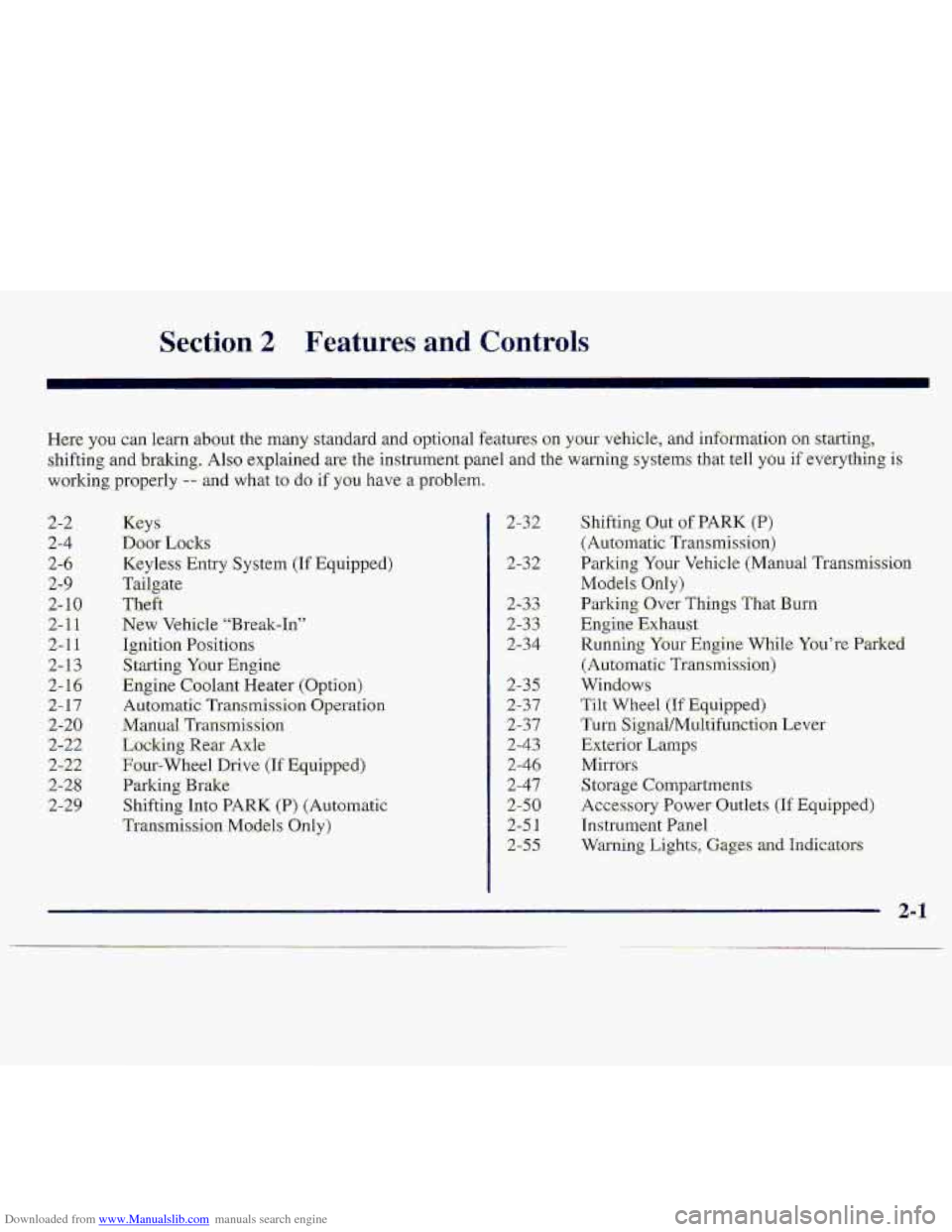
Downloaded from www.Manualslib.com manuals search engine Section 2 Features and Controls
Here y~u can learn about the many standard and opti-onal features o.n your-vehide, and irkofmation on starting,,
shifting
and braking. Also explained are the instrument panel and, the warning systems that teil you if everything is
working properly -- and what to do if you have a problem.
Keys
Door L.ocks
Key1e.s~ Entry 'System- (If Equipped)
Tailgate
Theft
Ne.w Vihicle "Break-In"
Ignition Positions
S.tarting
You Engine
Engine Coolant Heater (Option)
htqmatic. Tr.ansmission Operation
Manual Trmsrnissio,n
Locking Rear Axle:
Four-wheel Drive (If Equipped)
Parking Brake.
Shi€ting
Into PARK (P) (Automatic
Transmission
Ma.dels Only)
2-32
2-52
2-33
2-3 3
2-34
2-35
2-3 7
2-37
2-43
2,-47
2-50
2-5 1
2-55
2-4-6;
Shifting Out of PARK (P)
(Auto'mmtic Transmission)
Parking
Your Vehicle (Manual Transmission
Models Only)
Parlung Qve.1- Things That Burn
.Engine
Exhaust
Running Your EQg-ine While YGu're Parked
(Automatic Transmission)
Windows
Ti it Wheel (If Equipped)
Turn Signal/Multi~~ncti-on- Lever
Exterior Lamps
'3 t-orage Compartments
Accessory
Power Outlets (If Equipped)
Tnstrument Panel
Warning
Lights; Gap .and Tndicatms
2-1
Page 63 of 402
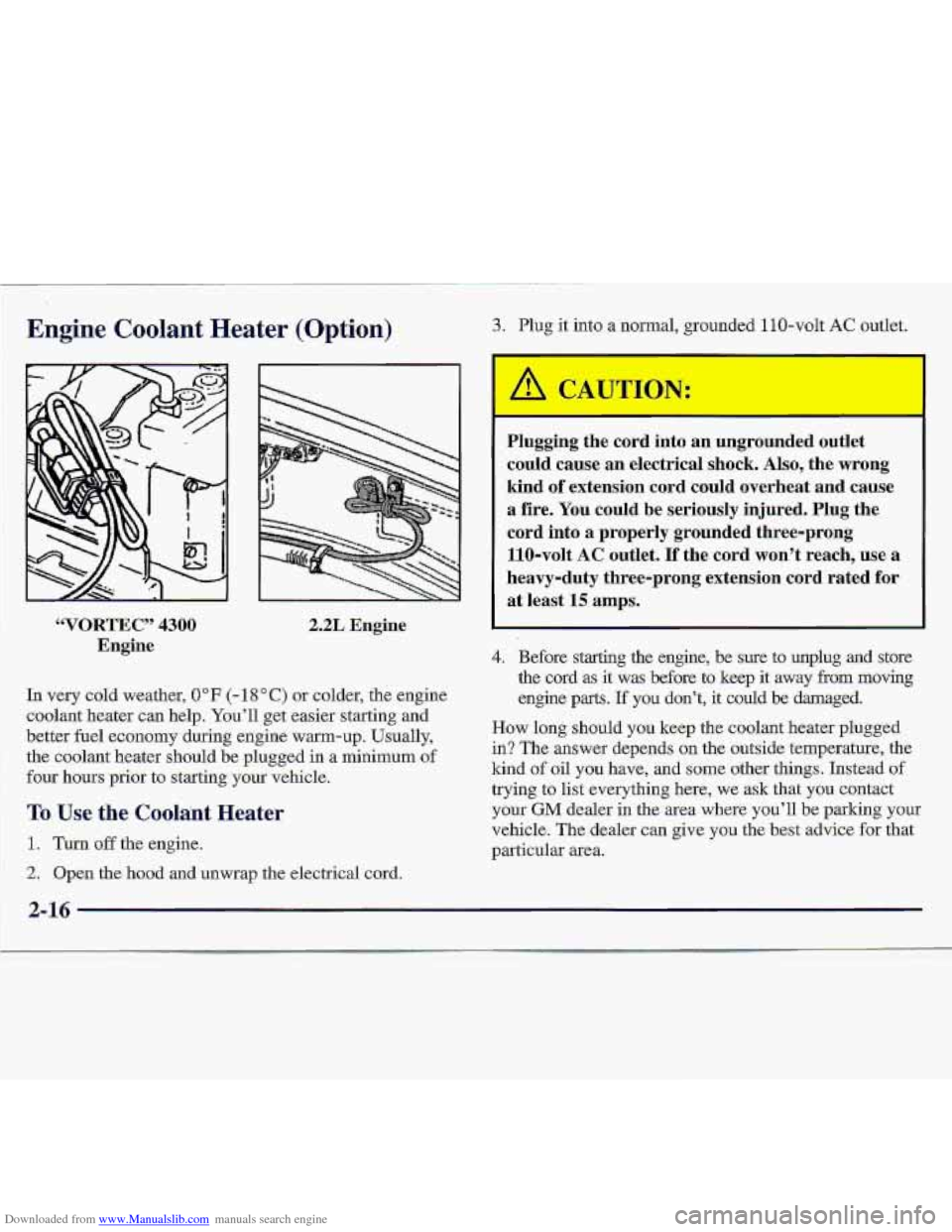
Downloaded from www.Manualslib.com manuals search engine Engine Codant Heater (Option) 3. Plug it into a normal, grounded 110-volt AC .outlet.
“VORTEC” 4301); 2.2L Engine
Engine
In very cold weather? 0 “F (- 18 * C) or colder, the engine
ooiantheater can help. You’ll get easier starting and
better
fuel economy during engine warm-up. Usually,
the coolant heater should be plugged in a
minimum of
four hours prior to statin-g your vehicle.
10 Use the- Coolant Heater
1. Turn off the- engine.
2. Open the hood and unwrap the ele.ctrica1 cord.
Plugging le cord into an-ungroundec let
could cause an electrical shock. Also, the wrong
kind of extension cord could overheat and cause:
a fire. You could be seriously injured. Plug the
cord into a properly grounded three-prong 110-volt
AC outlet. If the cord won’t reach, .use ,a
heavy-duty three-p.rong extension cord rated for
at least 15
amps.
4. Before starting the engine, be sure -to unplug. and store
the cord as
it was before tu keep it away from moving
engine parts. If you don%, it could b.e damaged.
How long should you keep the coolant heater plugged
in?.The answer depends on the-outside temperature, the
kind
.of ail you have, and some other things. Instead of
trying to list everything here, we ask that you contact
your GM dealer in the area where-you’Il be parking your
vehicle. The
dealer can give you the best advtce for that
particular area.
Page 115 of 402
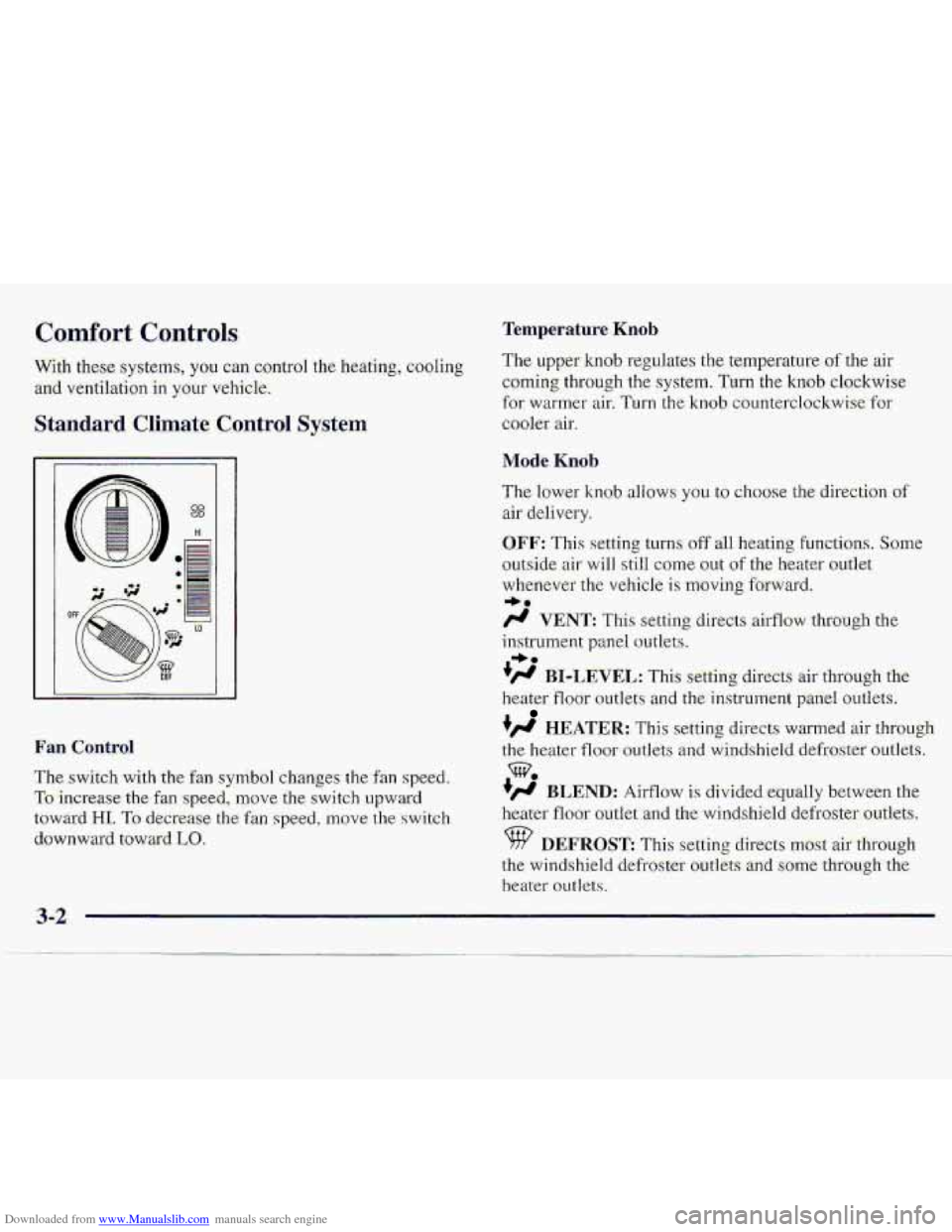
Downloaded from www.Manualslib.com manuals search engine Cumfort Controls Tempe. lure Knob
With these systems, you can control the heating, cooling
and ventilation in your vehis1.e;
Standa.rd Climate Control System
The: upper .. hob regulates the temperature .af the air
c:omi.n-g through the system. Turn the knob clockwise
for warmer air. Turn the knob countellclockwi,se-.%or
cooler air.
Mode Knob
Fan Control
The. switch withdx fan synib-01 changes the'-fan speed.
To increasethe $an -speed,, move the switch upward
t6wa.$d HI. To decrease the fan spe-ecl, move-the switch.
downward toward LO,
The lower knob allows you to c.11oose the direction of
air delivery.
OFF: This setting. turns-off all heating functions. Some
outside air will still come out of the heater outlet
wlrenever the: vehicle
is moving forward.
/J VENT: This setting directs airflow thmogh the
ins-trument p.anel outlets.
+fl BI-LEVEL: This setti'ng directs air through the
heater floor outlets and the-instrument palxel outkts.
+fl HEATER.: This setting directs warm.ed air through
the h-eater floor outlets and windshield defmstef outlets.
+' BLEND: Airflow is divided equally between the
he.ater
floor autiet and the- windshield. defro~skr outlets.
DEFROST This setting directs mbsf air thraugh
the windshield defroster ootlits. and sixhe through the
heater outlets.
-be
w.
Page 116 of 402
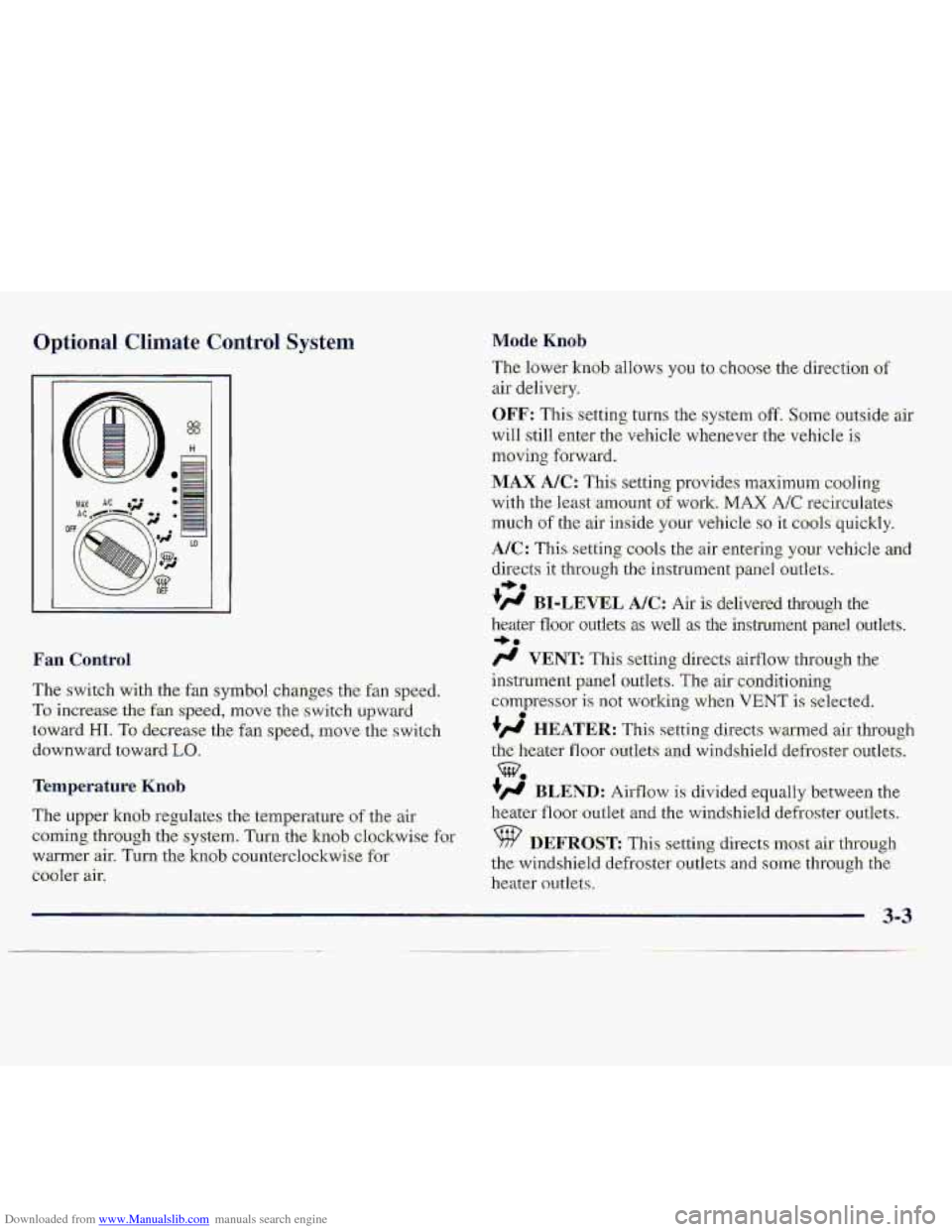
Downloaded from www.Manualslib.com manuals search engine Optional Climate Control System
The switch with the:fan symbol changes the fan speed.
To.increase the fa speed, rnove.the s-witch upwatd
towai-d HI. To -de.g-e.ase the fan speed, move the. swi.tch
downward toward
Lo.
Temperature Kmb
The uppe-r kn0.b regulates the .temperature of the air
corning thfuugh'the system. Turn the knob clchAwisc far
warmer
air. Turn the knab counterclockwise for
cbolet air.
Mode. Knob
The lower knob allows you to choose the direction of
aif delively.
OFF: This setting turns the system off. Some outside air
will still enter the vehicle whenever the vehicle i.s
tnsving foxward.
MAX. A/C: This setting pr0vi.de.s maximum coo,l.ing
with the 1east:amount of wor,k. MAX A/C recircalates
m.uch of the air-inside your vehicle so it c001.s quickly.
A/%: This setting cools the air erite-kng your vehicle and
directs it through th,e instrument pxnel outlets.
#' BI-LEVEL AK: Air is delivered thTough the
heater iloor outlets 8s well as the instmnent panel outlets.
/.I VENT: This setting directs airflow thr-ough the
instrument panel outlets.
The air conditioning
compresso~ is not working when VENT is selected.
+', HEATER: This s-etting directs warmed air th,rough
the heater floor outlets an-d winds-hield defroster outlets.
+' BLEND: Airflow is divided -equalfybetween the
heater
floor outlet and the windshield defroster outlets.
%? DEFROST This setti-ng direct,s ~OSC air. through
th,e windshield- defroster ou-tkts
.and Some thmugh the
heater owlets.
I, a.
3..
0
3-3
Page 117 of 402
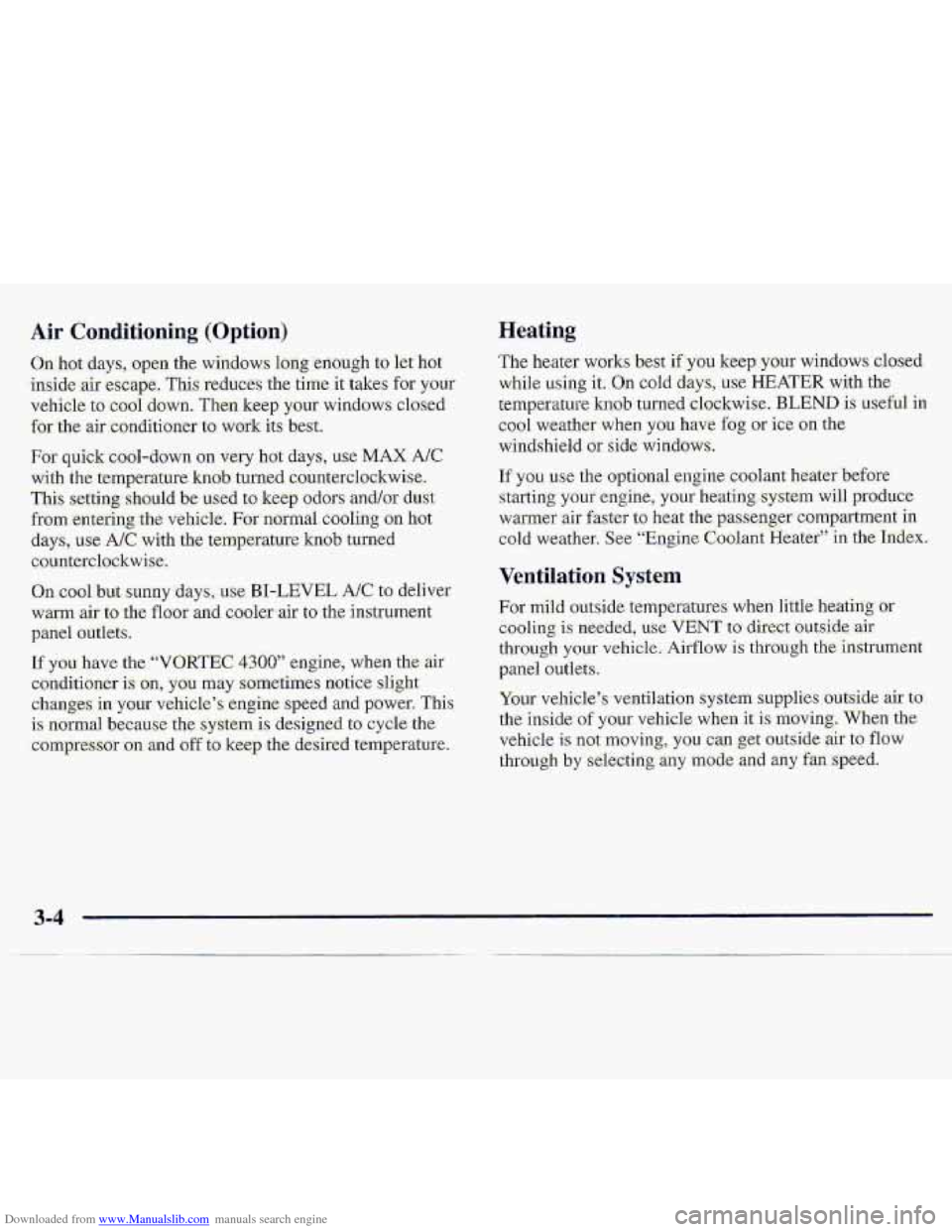
Downloaded from www.Manualslib.com manuals search engine Air Conditioning (Option) Heating
The heater -works best if'pu keep; you^ windows ck
whi1.e using it.. On cold days, us.e HEATER with the
temperature
knob-turned clockwise. BLEND iS .useful in
cool weather when you have fog or ice on the
wind-shield or side windows.
If yoLuse the- optional engirie coolant'heater before
starting your engine, your heating system will produce
warmer air fasier to heat the,pa,ssenger compartmgent in
cold. weather, 'S-ee "Engine Coolmt'Heater'' in the' Index,
Ventilation System
For mild outsid&:V3npaature:s when little heating or
c-ooling is needed, me VENT to: direct au.tsi.de. sir
through your vehic1.e. Airflow is tllrough the'ihnstrumalt
panel outlets.
Your vehicle's ventilation gystem supplies outside air to
the inside of your vehick wkin it is moving,. When the
.vehicle is not rn0vin.g you can-get outside ~r to ilow
-through by selecting any mode and an.y fan ,sp.ee.d.
3-4
Page 118 of 402
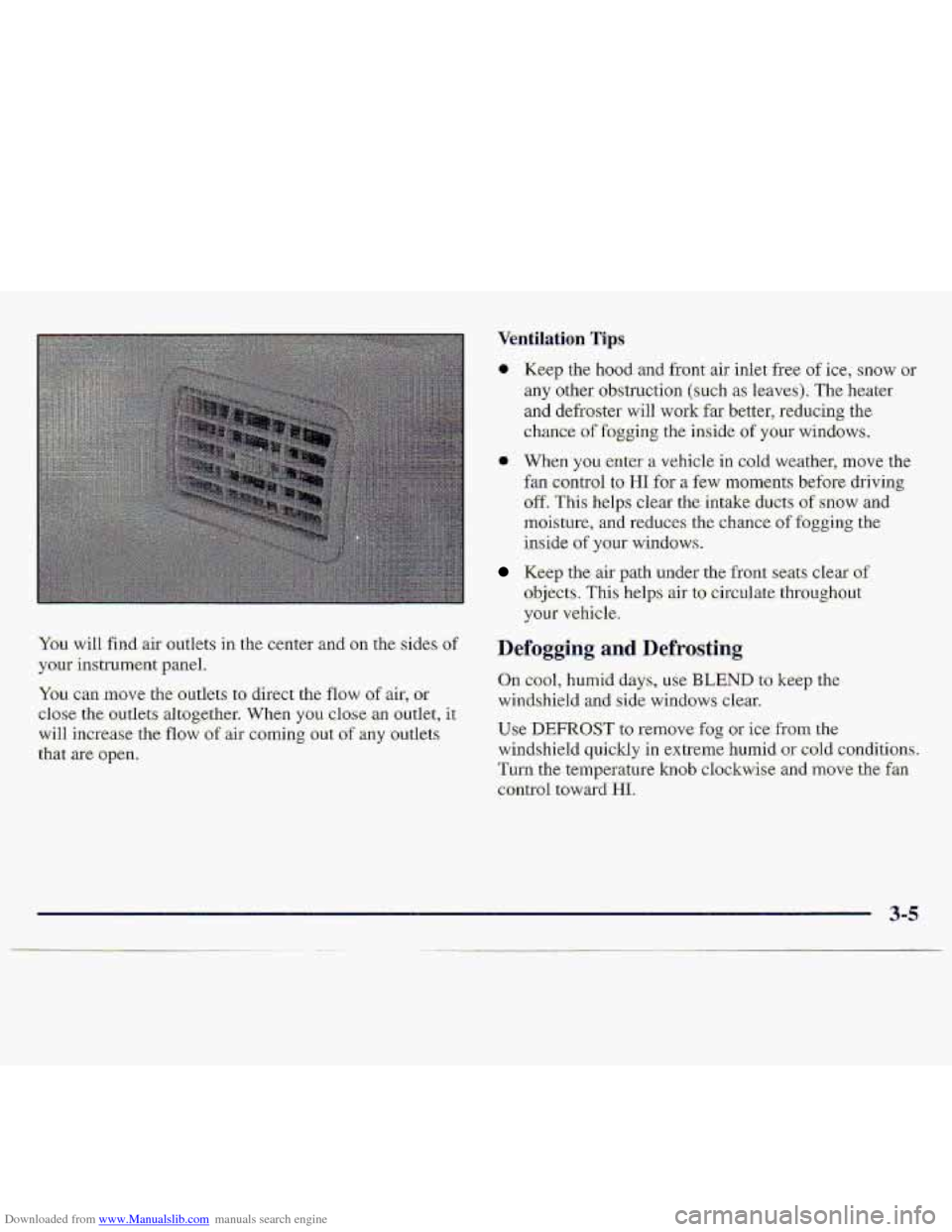
Downloaded from www.Manualslib.com manuals search engine You can mote the,outkts to direct the. flow of air; Gr
cl.os;e the out1et.s altogether. When you Close an outlet, it.
will increase the flow of air coming out p;.f any outl.ets
that
are open.
0 Keep the hood and front air inlet free of ice, snow or
any other obstruction (such as 1eave.s). The heater
and defroster will work-far better, reducing the
chance of fogging the inside- of your windows.
a When you enter a vehicle in cold:weather, move the
€an
control to HI for a few moments. before driving-
off. This helps clear the intake ducts of snow and
moisture, and re-duces the chance
of fogging .the
inside
of your windows.
Keep the air path under the front se.ats clear of
objects. This he1p.s air to- circulate throughout
your vehicle.
Defogging and- Defrosting
On cool, Ilumid days, use BLEND to keep me
windshield and side windows clear.
Use DEFROST to remove fog or ice from the
windshield quickly .in extreme humid
or .cold conditions.
Turn
the temperature knob clockwise ,and move the fan
control toward HI,
Page 210 of 402
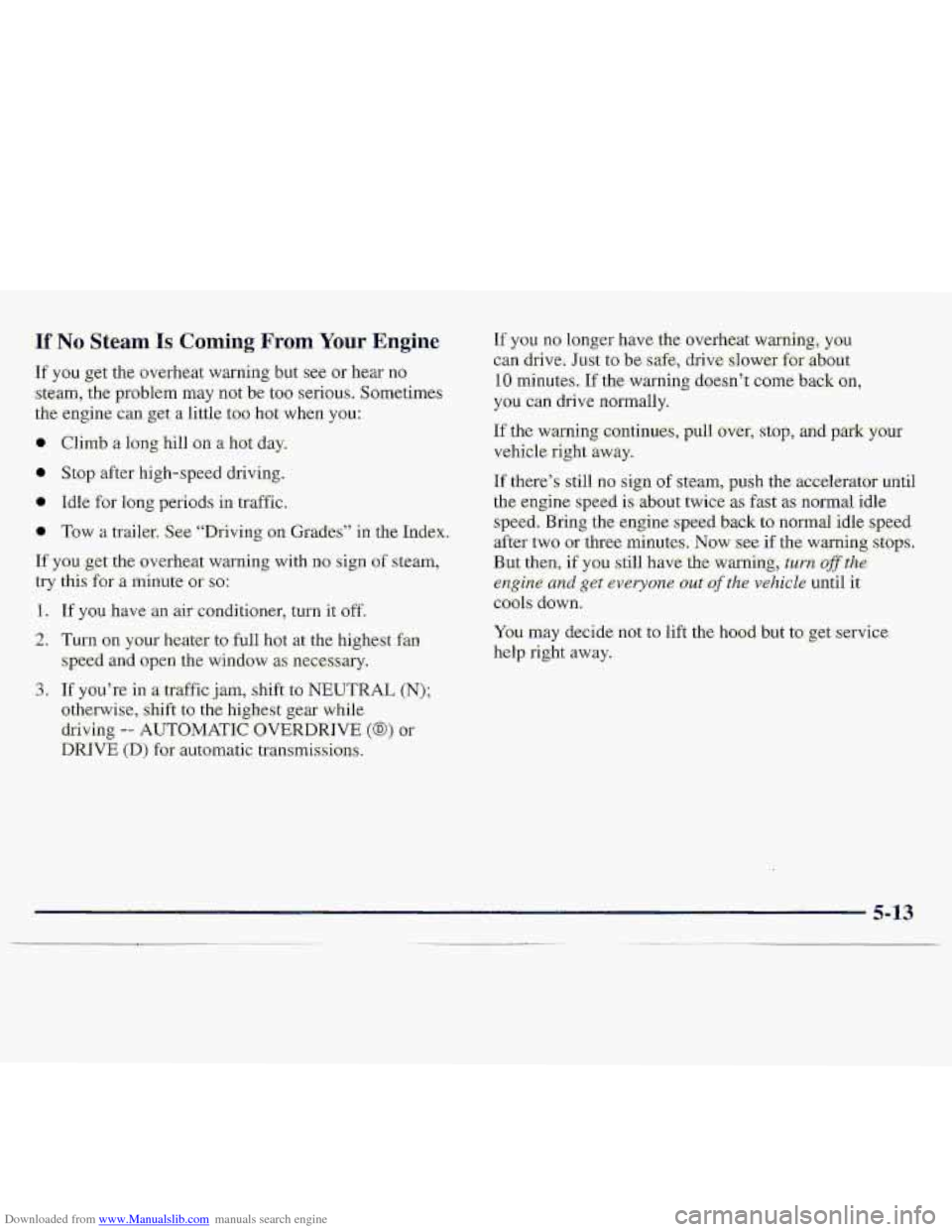
Downloaded from www.Manualslib.com manuals search engine IfNo Steam Is Coming -. From Your Engine
If y0.u get the overheat warning but s.ce or hear RO
steam, the problem may not be too serious. Sometimes
the engine
can get a 1i.ttle too hot when yau:
.O Climb a long hill OLI: a hot day.
0 S.top after high-speed driving.
0 Idle for long periods in traffic.
e- Tow a trailer. See “Dfiving on Grades” in .the Index.
If you get .the overheat warning with no sign of s-team;
try this for a minute or so:-
1. If you have an air conditioner, turn it off.
2. Turn on your heater to full hot at the highest.$gm
speed
and open the window as necessary.
3. 1% you’re in a. traffic jam, shift to NEUTRAL (N);
otherwise, shift to the highest gear while
driving -- AUTOMATlC OVERDRIVE (@) or
DRIVE (D) far automatic transmissions.
If you n.0 longer have the overheat warniiqg,. you
can drive. Just to besafe, driv.e slower for .about
10 minu.tes. If the
warning does;n’.t come back. ofl,
you can drive normdly..
If the warning c.aritinues-, pull OV&, stop, and p-~k y.Our-
vehicle right hway.
If there’s still no sign of steam, push the accelerator Uhtil
the
engine speed is about twice as fast-as normal idie
speed. Bring the. engine speed back to- normal idle sped
after two QP three minutes. Now:s.ye if the warning, stops.
But
&en-, if you still have the .warnhg-, twn qfl--fhc
engine and get Gveryona .out af rhe whicle until it
coois Eo wn.
Page 212 of 402
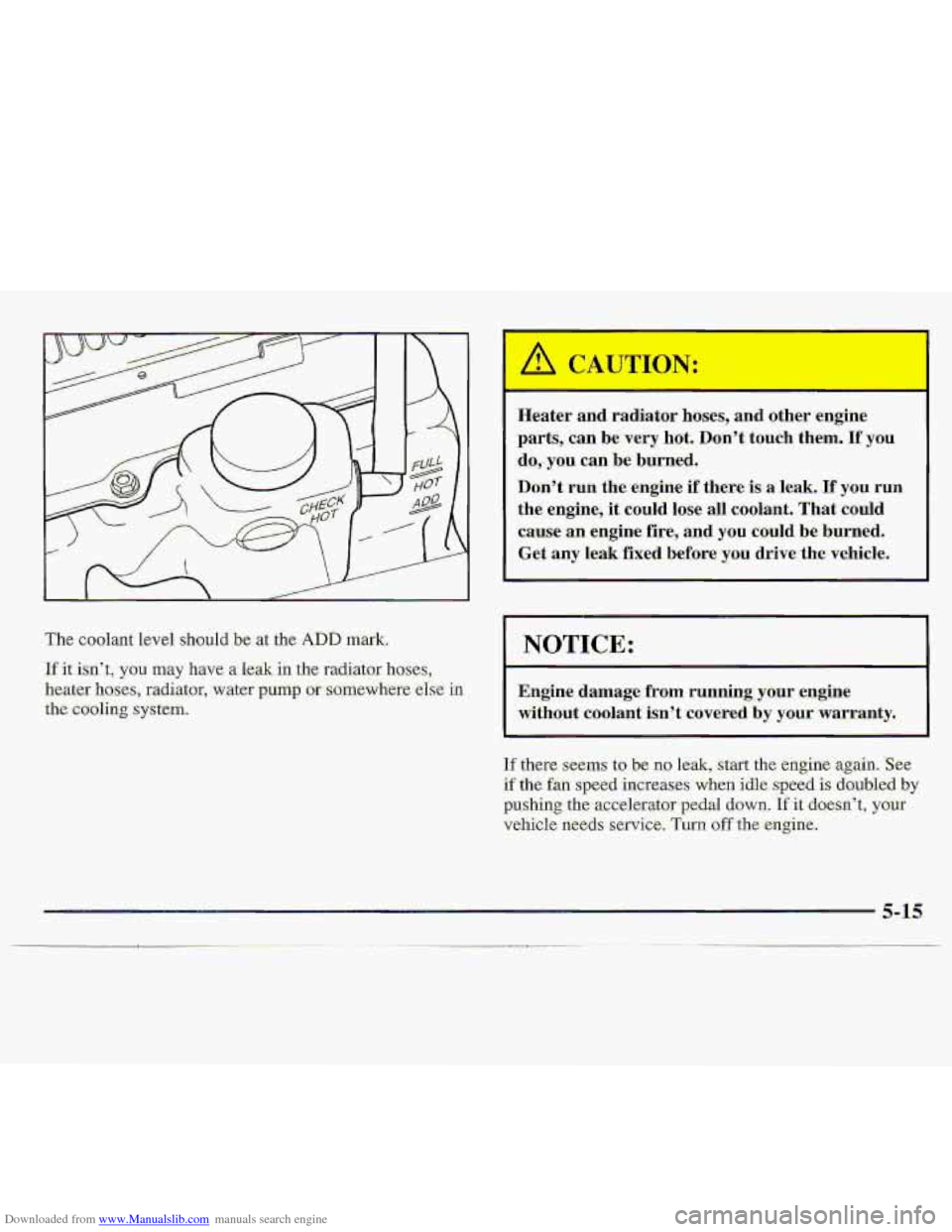
Downloaded from www.Manualslib.com manuals search engine L
The coolant level should be at the ADD mark.
If it isn’t, you may have, a-le-& in the mdiator hoses,
heater hoses, radiator, water pump 01 ?mewbere else in
the cdoling. system.
1
heater and radiator noses, and other engine
parts, can be. very hat. Don’t touch them. If you
do,, you can be burned.
Don’t
run the engine if there is a leak. If you run
the engine, it could lose all coolant. That could
cause ,an engine fire,
and you could be burned.
Get any leak fixed before you drive the vehicle.
I NOTICE:
-.
Engine damage from running your ,engine
without coolant isn’t
covered by your warranty.
If there seems to be no leak, start the fine again, :See
if the fan speed increases when idle sped is -doubled by
pushing the -accelerator pedal down. If it doesn’t, your
vehicle needs service. Turn off-the engine.